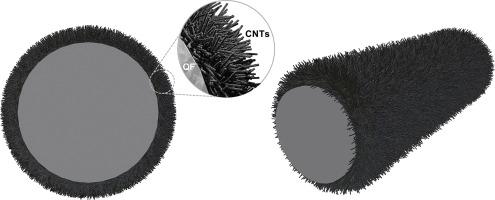当前位置:
X-MOL 学术
›
Compos. Sci. Technol.
›
论文详情
Our official English website, www.x-mol.net, welcomes your
feedback! (Note: you will need to create a separate account there.)
Piezoresistive structural composites reinforced by carbon nanotube-grafted quartz fibres
Composites Science and Technology ( IF 8.3 ) Pub Date : 2020-09-01 , DOI: 10.1016/j.compscitech.2020.108275 H.G. De Luca , D.B. Anthony , E.S. Greenhalgh , A. Bismarck , M.S.P. Shaffer
Composites Science and Technology ( IF 8.3 ) Pub Date : 2020-09-01 , DOI: 10.1016/j.compscitech.2020.108275 H.G. De Luca , D.B. Anthony , E.S. Greenhalgh , A. Bismarck , M.S.P. Shaffer

|
Abstract Nano-engineered fibre/matrix interfaces can improve state-of-the-art fibre-reinforced composites. Grafting carbon nanotubes (CNTs) to high temperature quartz glass fibres produces “hairy” or “fuzzy” fibres, which combine reinforcements at micrometre and nanometre length scales. Fuzzy quartz fibres were produced continuously, reel-to-reel, on whole tows, in an open chemical vapour deposition reactor. The resulting uniform coverage of 200 nm long CNTs increased the interfacial shear strength with epoxy (90.3 ± 2.1 MPa) by 12% compared to the commercially-sized counterpart, as measured by single fibre pull-out tests. The improved interfacial properties were confirmed at the macroscale using unidirectional hierarchical bundle composites, which exhibited a delayed onset of fibre/matrix debonding. Although the quartz fibres are electrically insulating, the grafted CNT create a conductive path, predominantly parallel to the fibres. To explore the applicability for structural health monitoring, the resistivity was recorded in situ during mechanical testing, and correlated with simultaneous acoustic emission data. The baseline resistivity parallel to the fibres (ρ0 = 3.9 ± 0.4 × 10−1 Ω m) displayed a linear piezoresistive response (K = 3.64) until failure at ca. 2.1% strain, also referred to as "gauge factor”, a two-fold improvement over traditional resistance strain gauges (e.g. constantan). Hierarchical, fuzzy quartz fibres, therefore, simultaneously enhance both structural and sensing performance, offering multifunctional opportunities in large composite parts.
中文翻译:

碳纳米管接枝石英纤维增强压阻结构复合材料
摘要 纳米工程纤维/基质界面可以改进最先进的纤维增强复合材料。将碳纳米管 (CNT) 接枝到高温石英玻璃纤维上会产生“毛状”或“模糊”纤维,它们结合了微米和纳米长度尺度的增强材料。在开放式化学气相沉积反应器中,整根丝束连续生产模糊石英纤维。通过单纤维拉出测试测量,与商业尺寸的对应物相比,由此产生的 200 nm 长碳纳米管的均匀覆盖使环氧树脂的界面剪切强度 (90.3 ± 2.1 MPa) 提高了 12%。使用单向分层束复合材料在宏观尺度上证实了改进的界面性能,其表现出纤维/基质脱粘的延迟开始。尽管石英纤维是电绝缘的,但接枝的 CNT 形成了一条主要平行于纤维的导电路径。为了探索结构健康监测的适用性,在机械测试期间原位记录电阻率,并与同步声发射数据相关联。平行于纤维的基线电阻率 (ρ0 = 3.9 ± 0.4 × 10−1 Ω m) 显示线性压阻响应 (K = 3.64),直到在大约 10 处失效。2.1% 应变,也称为“应变系数”,是传统电阻应变计(例如康铜)的两倍。因此,分层的模糊石英纤维同时增强结构和传感性能,为大型复合材料提供多功能机会部分。主要平行于纤维。为了探索结构健康监测的适用性,在机械测试期间原位记录电阻率,并与同步声发射数据相关联。平行于纤维的基线电阻率 (ρ0 = 3.9 ± 0.4 × 10−1 Ω m) 显示线性压阻响应 (K = 3.64),直到在大约 10 处失效。2.1% 应变,也称为“应变系数”,是传统电阻应变计(例如康铜)的两倍。因此,分层的模糊石英纤维同时增强结构和传感性能,为大型复合材料提供多功能机会部分。主要平行于纤维。为了探索结构健康监测的适用性,在机械测试期间原位记录电阻率,并与同步声发射数据相关联。平行于纤维的基线电阻率 (ρ0 = 3.9 ± 0.4 × 10−1 Ω m) 显示线性压阻响应 (K = 3.64),直到在大约 10 处失效。2.1% 应变,也称为“应变系数”,是传统电阻应变计(例如康铜)的两倍。因此,分层的模糊石英纤维同时增强结构和传感性能,为大型复合材料提供多功能机会部分。并与同步声发射数据相关联。平行于纤维的基线电阻率 (ρ0 = 3.9 ± 0.4 × 10−1 Ω m) 显示线性压阻响应 (K = 3.64),直到在大约 10 处失效。2.1% 应变,也称为“应变系数”,是传统电阻应变计(例如康铜)的两倍。因此,分层的模糊石英纤维同时增强结构和传感性能,为大型复合材料提供多功能机会部分。并与同步声发射数据相关联。平行于纤维的基线电阻率 (ρ0 = 3.9 ± 0.4 × 10−1 Ω m) 显示线性压阻响应 (K = 3.64),直到在大约 10 处失效。2.1% 应变,也称为“应变系数”,是传统电阻应变计(例如康铜)的两倍。因此,分层的模糊石英纤维同时增强结构和传感性能,为大型复合材料提供多功能机会部分。
更新日期:2020-09-01
中文翻译:

碳纳米管接枝石英纤维增强压阻结构复合材料
摘要 纳米工程纤维/基质界面可以改进最先进的纤维增强复合材料。将碳纳米管 (CNT) 接枝到高温石英玻璃纤维上会产生“毛状”或“模糊”纤维,它们结合了微米和纳米长度尺度的增强材料。在开放式化学气相沉积反应器中,整根丝束连续生产模糊石英纤维。通过单纤维拉出测试测量,与商业尺寸的对应物相比,由此产生的 200 nm 长碳纳米管的均匀覆盖使环氧树脂的界面剪切强度 (90.3 ± 2.1 MPa) 提高了 12%。使用单向分层束复合材料在宏观尺度上证实了改进的界面性能,其表现出纤维/基质脱粘的延迟开始。尽管石英纤维是电绝缘的,但接枝的 CNT 形成了一条主要平行于纤维的导电路径。为了探索结构健康监测的适用性,在机械测试期间原位记录电阻率,并与同步声发射数据相关联。平行于纤维的基线电阻率 (ρ0 = 3.9 ± 0.4 × 10−1 Ω m) 显示线性压阻响应 (K = 3.64),直到在大约 10 处失效。2.1% 应变,也称为“应变系数”,是传统电阻应变计(例如康铜)的两倍。因此,分层的模糊石英纤维同时增强结构和传感性能,为大型复合材料提供多功能机会部分。主要平行于纤维。为了探索结构健康监测的适用性,在机械测试期间原位记录电阻率,并与同步声发射数据相关联。平行于纤维的基线电阻率 (ρ0 = 3.9 ± 0.4 × 10−1 Ω m) 显示线性压阻响应 (K = 3.64),直到在大约 10 处失效。2.1% 应变,也称为“应变系数”,是传统电阻应变计(例如康铜)的两倍。因此,分层的模糊石英纤维同时增强结构和传感性能,为大型复合材料提供多功能机会部分。主要平行于纤维。为了探索结构健康监测的适用性,在机械测试期间原位记录电阻率,并与同步声发射数据相关联。平行于纤维的基线电阻率 (ρ0 = 3.9 ± 0.4 × 10−1 Ω m) 显示线性压阻响应 (K = 3.64),直到在大约 10 处失效。2.1% 应变,也称为“应变系数”,是传统电阻应变计(例如康铜)的两倍。因此,分层的模糊石英纤维同时增强结构和传感性能,为大型复合材料提供多功能机会部分。并与同步声发射数据相关联。平行于纤维的基线电阻率 (ρ0 = 3.9 ± 0.4 × 10−1 Ω m) 显示线性压阻响应 (K = 3.64),直到在大约 10 处失效。2.1% 应变,也称为“应变系数”,是传统电阻应变计(例如康铜)的两倍。因此,分层的模糊石英纤维同时增强结构和传感性能,为大型复合材料提供多功能机会部分。并与同步声发射数据相关联。平行于纤维的基线电阻率 (ρ0 = 3.9 ± 0.4 × 10−1 Ω m) 显示线性压阻响应 (K = 3.64),直到在大约 10 处失效。2.1% 应变,也称为“应变系数”,是传统电阻应变计(例如康铜)的两倍。因此,分层的模糊石英纤维同时增强结构和传感性能,为大型复合材料提供多功能机会部分。











































 京公网安备 11010802027423号
京公网安备 11010802027423号